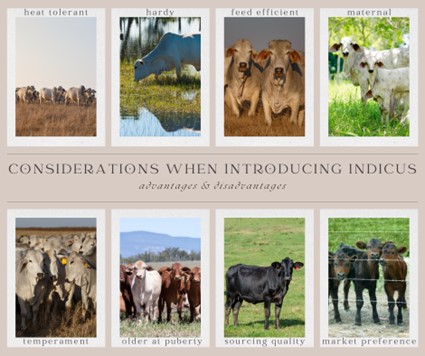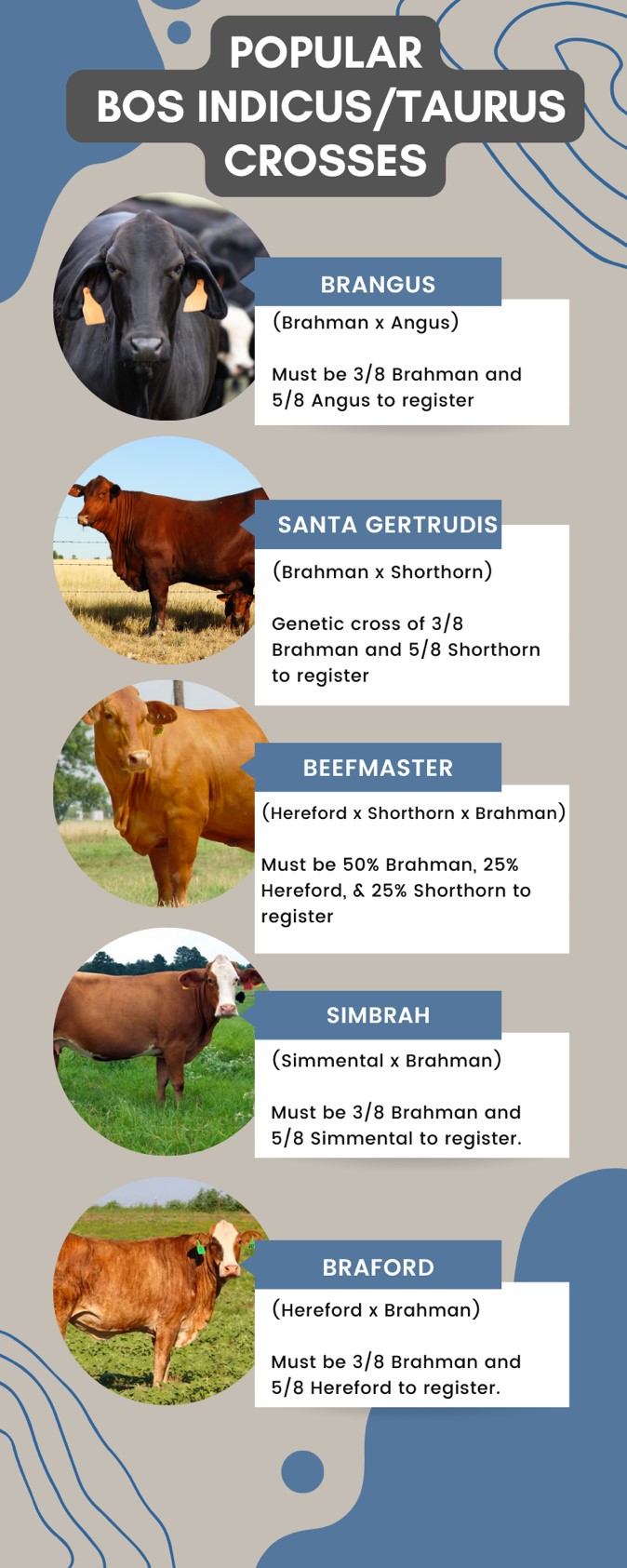
Keeping Cool in the Pasture:
Harnessing Indicus Cattle Genetics for Heat Tolerance in Your Herd

The undeniable trend of increasing heat indices in the United States has had profound implications for cattle producers, particularly in regions unaccustomed to extreme heat. Traditionally cooler climates, like those in the Midwest and Northern states, are now grappling with the challenge of heat stress in their cattle herds. To counteract the serious side effects of heat stress, producers have had to implement a range of heat mitigation strategies. These include the provision of more shade, installation of fans in barns, water sprinkler systems, relocating cattle to pastures with readily available bodies of water, and increasing the number of water sources in pastures. However, these measures often come at a significant cost and, in some cases, offer limited relief during sweltering conditions. Consequently, many cattle experts are increasingly advocating for the incorporation of Indicus genetics into cattle operations across the United States in the coming years. The unique heat tolerance and adaptability traits of Indicus cattle could prove invaluable in safeguarding the health, productivity, and reproductive efficiency of herds in the face of escalating temperatures.
The world of agriculture is constantly evolving, with innovative methods and technologies emerging to improve the efficiency and productivity of livestock operations. One such development that has gained traction in recent years is the incorporation of Indicus cattle genetics into traditional Bos Taurus cow-calf herds. Indicus cattle, also known as Bos indicus, represent a distinct genetic lineage within the cattle species, characterized by their adaptability to challenging environments, resistance to heat stress, maternal instincts, and unique physiological traits. In this blog post, we will explore the benefits and considerations of introducing Indicus cattle genetics into your cow-calf herd.
Understanding Indicus Cattle Genetics Indicus cattle, native to regions of Asia and Africa, have evolved over millennia to thrive in diverse and often harsh environments. Their genetic makeup equips them with features that allow them to effectively cope with heat, parasites, and scarcity of resources. These unique traits include a hump over their shoulders, a loose and wrinkled skin, and a high tolerance to tropical diseases. The most well-known breed within the Indicus lineage is the Brahman, but there are other breeds like the Nellore, Gir, and Sahiwal that also possess these beneficial traits. These breeds are crossed with common high performing Bos Taurus breeds such as Angus, Shorthorn, Hereford, and Charolais.
Advantages of Introducing Indicus Genetics
- Environmental Adaptability: One of the primary advantages of incorporating Indicus genetics into your herd is their remarkable ability to adapt to various climatic conditions. If you're operating in regions with high temperatures and humidity, Indicus genetics can contribute to heat tolerance and reduced stress, resulting in healthier animals and increased productivity.
- Disease Resistance: Indicus cattle have evolved alongside tropical diseases and parasites, leading to a natural resistance to many common livestock ailments, such as external parasites. By integrating these genetics, you can potentially reduce the need for extensive medical interventions, ultimately saving on veterinary costs and minimizing the use of antibiotics.
- Reproductive Efficiency: Indicus cattle are known for their reproductive resilience in challenging environments. They often exhibit better calving rates and maternal instincts, contributing to higher calf survival rates and an overall more efficient breeding program. However, these cattle reach puberty later than their Taurus counterparts, so they must be managed slightly differently to optimize pregnancy rates.
- Efficient Feed Conversion: Indicus cattle have developed efficient digestive systems that allow them to extract maximum nutrients from forage, even in less-than-optimal conditions. This can lead to improved feed efficiency, which translates into better weight gains and reduced feed costs. Indicus cattle are often found grazing even in extreme temperatures.
Considerations and Challenges
While the benefits of introducing Indicus genetics are significant, there are several considerations that should be taken into account:
- Crossbreeding Strategy: Introducing Indicus genetics is typically done through crossbreeding with existing cattle breeds. Developing a clear breeding strategy that takes into account the desired traits, breed compatibility, and long-term goals of your operation is essential. However, there are well established seedstock operations that regularly market heifers, bulls, bred heifers/cows, and open cows.
- Market Preferences: Depending on your geographical location and market demand, there might be preferences for certain cattle breeds. It's important to research and understand the market dynamics before making significant genetic changes to your herd.
- Learning Curve: Managing a crossbred herd requires a certain level of expertise and knowledge about the specific traits of both parent breeds. Familiarize yourself with the nuances of Indicus genetics to ensure effective management and decision-making, especially in reproductive management.
- Genetic Selection: Not all Indicus cattle possess the same set of desirable traits. Careful genetic selection is crucial to ensure that you're incorporating genetics that align with your herd's specific needs and goals.
Sourcing Crossbred Cattle:
Sourcing crossbred cattle, particularly those with a combination of Indicus and Taurus genetics, requires careful consideration of your breeding goals, local availability, and the reputation of cattle suppliers. Below is a suggested checklist to effectively source crossbred cows.
- Identify Reputable Breeders and Suppliers: To start, research and identify reputable breeders and cattle suppliers in your region or within a reasonable distance. Word-of-mouth recommendations from fellow cattle producers and local agricultural associations can be invaluable in finding reliable sources. Reputable breeders often have a track record of producing healthy and genetically sound crossbred cattle. Avoid purchasing from the sale barn when starting to ensure you are adding high quality genetics.
- Define Your Breeding Goals: Before sourcing crossbred cows, define your specific breeding objectives. Are you aiming for a particular combination of Indicus and Taurus genetics to maximize heat tolerance, meat quality, or other traits? Knowing your goals will help you narrow down your search and make informed decisions when selecting cattle.
- Attend Cattle Auctions and Sales: Cattle auctions and sales events, whether in person or online, can be excellent places to find crossbred cattle. Be prepared to ask questions about the cattle's genetics, health history, and performance records. Auctions also provide an opportunity to see a wide range of cattle in one place, giving you more choices.
- Consult Breed Associations:Reach out to breed associations for both Indicus and Taurus breeds to inquire about reputable breeders or upcoming sales that feature crossbred cattle. These associations can provide valuable information and connect you with breeders who specialize in crossbreeding.
- Perform Health and Genetic Testing: Once you've identified potential sources, consider conducting health and genetic testing on the cattle you intend to purchase. This includes assessing their vaccination history, disease status, and genetic traits relevant to your breeding goals. Testing can help ensure that you're acquiring cattle that align with your objectives. Reputable breeders often genetic test their calves and have that information available to buyers.
- Visit Farms and Inspect Cattle: Whenever possible, visit the farms or facilities where the crossbred cattle are raised. This allows you to inspect the living conditions, overall health of the herd, and the cattle's temperament. Physically seeing the cattle and their environment can help you make more informed decisions.
- Negotiate Terms and Contracts:Before finalizing any purchases, negotiate terms and contracts with the seller. Clarify details about transportation, health certifications, and any guarantees regarding the cattle's performance and health after purchase.
Sourcing crossbred Indicus/Taurus cows requires a combination of research, networking, and due diligence. By carefully selecting reputable sources and aligning your choices with your breeding objectives, you can acquire crossbred cattle that contribute positively to your herd's genetic diversity and overall performance.
Conclusion
Incorporating Indicus cattle genetics into your cow-calf herd presents a promising avenue for improving adaptability, disease resistance, reproductive efficiency, and feed conversion. These genetics have been fine-tuned through centuries of natural selection, making them well-suited for various agricultural contexts. However, careful planning, a well-defined breeding strategy, and a thorough understanding of both Indicus and existing breed genetics are imperative for a successful transition. By embracing these genetics, you're not only enhancing the performance of your herd but also embracing a piece of the rich history and evolution of the cattle species.


|
|
|